Genesis of the Laoliwan Ag-Pb-Zn Deposit, Southern Margin of the North China Craton, China: Constrained by C-H-O-S-Pb Isotopes and Sulfide Rb-Sr Geochronology
Abstract
1. Introduction
2. Geological Setting
2.1. Regional Geology
2.2. Deposit Geology
3. Sampling and Analytical Methods
3.1. Rb-Sr Isotope Dating
3.2. C-H-O-S-Pb Isotope Analyses
4. Results
4.1. Rb-Sr Isochron Age
4.2. Hydrogen and Oxygen Isotopic Compositions
4.3. Carbon Isotopic Compositions
4.4. Sulfur Isotopic Compositions
4.5. Lead Isotopic Compositions
5. Discussion
5.1. Timing of Ag-Pb-Zn Mineralization
5.2. Sources of Ore-Forming Fluids and Materials
5.3. Ore Genesis and Prospecting Direction
6. Conclusions
- The Laoliwan Ag-Pb-Zn deposit district is the first large-scale deposit discovered in the shallow-covered eastern Xiaoshan district. The ore bodies mainly occur within the Laoliwan granite porphyry intrusion and are controlled by NW-trending faults. The wall-rock alteration and mineral paragenetic assemblage show typical medium- to low-temperature characteristics.
- The Rb-Sr isochron age of sulfides (sphalerite and pyrite) is determined to be 132.8 ± 9.8 Ma (MSWD = 0.44). It is interpreted as the timing of Ag-Pb-Zn mineralization occurring in the early Cretaceous.
- The C-H-O-S-Pb isotopic compositions, combined with the initial ratio of 87Sr/86Sr, indicate that the ore-forming material originated from deep-seated magma.
- The Laoliwan Ag-Pb-Zn deposit is classified as an epithermal deposit, which formed in a lithospheric thinning tectonic setting related to the subduction of the Paleo-Pacific Plate during the early Cretaceous.
- The metallogenic model for the Laoliwan Ag-Pb-Zn deposit has been established, and there is potential for the discovery of concealed porphyry Cu-Mo mineralization at depth. Silver–lead–zinc and molybdenum–copper mineralization belong to the same metallogenic system.
Author Contributions
Funding
Data Availability Statement
Acknowledgments
Conflicts of Interest
References
- Xu, J.; Ma, C.; Yin, S.; Chang, Y.; Jia, H.; Wang, Z.; Shi, L. Geology, Mineralogy, and Isotopic Characteristics of the Zhonghe Ag−Pb−Zn Deposit, Western Henan Province, Central China. J. Earth Sci. 2022, 33, 177–192. [Google Scholar] [CrossRef]
- Mao, J.; Xie, G.; Bierlein, F.; Qü, W.; Du, A.; Ye, H.; Pirajno, F.; Li, H.M.; Guo, B.; Li, Y.; et al. Tectonic Implications from Re–Os Dating of Mesozoic Molybdenum Deposits in the East Qinling–Dabie Orogenic Belt. Geochim. Cosmochim. Acta 2008, 72, 4607–4626. [Google Scholar] [CrossRef]
- Mao, J.; Pirajno, F.; Cook, N. Mesozoic Metallogeny in East China and Corresponding Geodynamic Settings—An Introduction to the Special Issue. Ore Geol. Rev. 2011, 43, 1–7. [Google Scholar] [CrossRef]
- Chen, Y.; Pirajno, F.; Sui, Y. Isotope Geochemistry of the Tieluping Silver-Lead Deposit, Henan, China: A Case Study of Orogenic Silver-Dominated Deposits and Related Tectonic Setting. Miner. Depos. 2004, 39, 560–575. [Google Scholar] [CrossRef]
- Zhao, T.; Meng, L.; Gao, X.; Jin, C.; Wu, Q.; Bao, Z. Late Mesozoic Felsic Magmatism and Mo-Au-Pb-Zn Mineralization in the Southern Margin of the North China Craton: A Review. J. Asian Earth Sci. 2018, 161, 103–121. [Google Scholar] [CrossRef]
- Li, J.W.; Bi, S.J.; Selby, D.; Chen, L.; Vasconcelos, P.; Thiede, D.; Zhou, M.F.; Zhao, X.F.; Li, Z.K.; Qiu, H.N. Giant Mesozoic Gold Provinces Related to the Destruction of the North China Craton. Earth Planet. Sci. Lett. 2012, 349–350, 26–37. [Google Scholar] [CrossRef]
- Li, Z.K.; Bi, S.J.; Li, J.W.; Zhang, W.; Cooke, D.R.; Selby, D. Distal Pb-Zn-Ag Veins Associated with the World-Class Donggou Porphyry Mo Deposit, Southern North China Craton. Ore Geol. Rev. 2017, 82, 232–251. [Google Scholar] [CrossRef]
- Li, Z.K.; Li, J.W.; Zhao, X.F.; Zhou, M.F.; Selby, D.; Bi, S.J.; Sui, J.X.; Zhao, Z.J. Crustal-Extension Ag-Pb-Zn Veins in the Xiong’ershan District, Southern North China Craton: Constraints from the Shagou Deposit. Econ. Geol. 2013, 108, 1703–1729. [Google Scholar] [CrossRef]
- Li, Z.; Li, X.; Jin, X.; Gao, K. Age and Genesis of the Laodaizhanggou Pb-Zn-Ag Deposit in the Fudian Ore Field, Southern North China Craton: Implications for Regional Mineral Prospecting. J. Earth Sci. 2021, 32, 195–207. [Google Scholar] [CrossRef]
- Li, Z.K.; Wang, C.; Wang, Z.Q.; Li, K.W.; Zhou, J.J.; Li, X.M.; Hu, J.; Zhang, J. A Giant Porphyry-Skarn-Epithermal Mo-W-Cu-Zn-Pb-Ag Metallogenic System in the Nannihu Ore Field, Southern North China Craton: Constraints from New Geochronological and Pyrite Geochemical Data. Ore Geol. Rev. 2023, 163, 105792. [Google Scholar] [CrossRef]
- Tang, W.; Ye, H.; Wang, P.; Wang, C.; Li, X.; Shi, H.; Chen, G. Geochronology of the Shenjiayao Gold Deposit in the Southern North China Craton: Constraints from in Situ Monazite U-Pb and Mica Rb-Sr Dating. Ore Geol. Rev. 2023, 160, 105607. [Google Scholar] [CrossRef]
- Gao, X.Y.; Zhao, T.P.; Bao, Z.-W.; Yang, A.Y. Petrogenesis of the Early Cretaceous Intermediate and Felsic Intrusions at the Southern Margin of the North China Craton: Implications for Crust–Mantle Interaction. Lithos 2014, 206–207, 65–78. [Google Scholar] [CrossRef]
- Zheng, Y.; Yu, P.-P.; Li, Z.-K.; Xiong, S.-F.; Zhou, L.-L.; Zhou, J.-X.; Wang, C.-M.; Meng, Y.-M.; Zhang, Y.; Wang, Y.-J.; et al. Critical Metals Ga, Ge and In in the Global Pb-Zn Deposits: Current Understanding, Challenges and Perspectives. J. Earth Sci. 2023, 34, 1308–1311. [Google Scholar] [CrossRef]
- Wang, C.; He, X.; Yan, C.; Lü, W.; Sun, W. Ore Geology, and H, O, S, Pb, Ar Isotopic Constraints on the Genesis of the Lengshuibeigou Pb-Zn-Ag Deposit, China. Geosci. J. 2013, 17, 197–210. [Google Scholar] [CrossRef]
- Chen, Y.; Pirajno, F.; Sui, Y. Geology and D-O-C Isotope Systematics of the Tieluping Silver Deposit, Henan, China: Implications for Ore Genesis. Acta Geol. Sin. (Engl. Ed.) 2005, 79, 106–119. [Google Scholar]
- Han, J.S.; Yao, J.M.; Chen, H.Y.; Deng, X.H.; Ding, J.Y. Fluid Inclusion and Stable Isotope Study of the Shagou Ag–Pb–Zn Deposit, Luoning, Henan Province, China: Implications for the Genesis of an Orogenic Lode Ag–Pb–Zn System. Ore Geol. Rev. 2014, 62, 199–210. [Google Scholar] [CrossRef]
- Tian, Y.; Mao, J.; Jian, W.; Wang, Y.; Feng, R.; Ye, H.; Liu, J.; Wu, S.; Zhu, L.; Xu, H.; et al. Recognition of the Xiayu Intermediate-Sulfidation Epithermal Ag-Pb-Zn-Au(-Cu) Mineralization in the East Qinling Polymetallic Ore Belt, China: Constraints from Geology and Geochronology. Ore Geol. Rev. 2023, 156, 105398. [Google Scholar] [CrossRef]
- Wang, X.; Mao, J.; Zhang, C.; Zhang, D.; Zhang, X.; Tian, Y.; Jian, W.; Yang, M.; Liu, S.; Li, W.; et al. Structural Controls on Formation of the Xiayu Vein-Hosted Ag–Pb–Zn–Au Orefield during Intracontinental Extension along the Southern Margin of the North China Craton. Ore Geol. Rev. 2023, 163, 105743. [Google Scholar] [CrossRef]
- Xu, J.; Zhang, Y.; Li, K.; Zheng, C.; Li, X.; Jin, Z.; Wu, C.; Zhang, Z. The Ore Genesis of the Shagou Ag-Pb-Zn Deposit in the Southern North China Craton: Constraints from He-Ar-Pb Isotopes and Trace Element Compositions of Sphalerite. Ore Geol. Rev. 2023, 163, 105765. [Google Scholar] [CrossRef]
- Ye, H.S.; Mao, J.W.; Li, Y.F.; Guo, B.J.; Zhang, C.Q.; Liu, J.; Yan, Q.R.; Liu, G.Y. SHRIMP Zircon U-Pb and Molybdenite Re-Os Datings of the Superlarge Donggou Porphyry Molybdenum Deposit in the East Qinling, China, and Its Geological Implications. Acta Geol. Sin. (Engl. Ed.) 2008, 82, 134–145. [Google Scholar]
- Jin, C.; Chen, W.T.; Gao, X.Y.; Li, X.C.; Bao, Z.W.; Zhao, T.-P. Origin of the Wangpingxigou Pb-Zn Deposit in East Qinling Orogenic Belt, China: Distal Response to the Giant Donggou Porphyry Mo System? Ore Geol. Rev. 2019, 109, 101–116. [Google Scholar] [CrossRef]
- Li, X.M. Metallogenic Mechanism of the Laoliwan Ag-Pb-Zn Deposit in the Xiaoshan District, Southern Margin of the North China Craton. Master Dissertation, China University of Geosciences, Beijing, China, 2020; pp. 1–94, (In Chinese with English summary). [Google Scholar]
- Leach, D.L.; Landis, G.P.; Hofstra, A.H. Metamorphic Origin of the Coeur d’Alene Base- and Precious-Metal Veins in the Belt Basin, Idaho and Montana. Geology 1988, 16, 122. [Google Scholar] [CrossRef]
- Lynch, J.V.G. Hydrothermal Zoning in the Keno Hill Silver-Lead-Zinc Vein System: A Study in Structural Geology, Mineralogy, Fluid Inclusions, and Stable Isotope Geochemistry. Doctoral Thesis, University of Alberta, Edmonton, AB, Canada, 1989. [Google Scholar]
- Beaudoin, G.; Sangster, D.F. A Descriptive Model for Silver-Lead-Zinc Veins in Clastic Metasedimentary Terranes. Econ. Geol. 1992, 87, 1005–1021. [Google Scholar] [CrossRef]
- Box, S.E.; Bookstrom, A.A.; Anderson, R.G. Origins of Mineral Deposits, Belt-Purcell Basin, United States and Canada: An Introduction. Econ. Geol. 2012, 107, 1081–1088. [Google Scholar] [CrossRef]
- Megaw, P.K.M.; Ruiz, J.; Titley, S.R. High-Temperature, Carbonate-Hosted Ag-Pb-Zn(Cu) Deposits of Northern Mexico. Econ. Geol. 1988, 83, 1856–1885. [Google Scholar] [CrossRef]
- Lawley, C.J.M.; Richards, J.P.; Anderson, R.G.; Creaser, R.A.; Heaman, L.M. Geochronology and Geochemistry of the MAX Porphyry Mo Deposit and Its Relationship to Pb-Zn-Ag Mineralization, Kootenay Arc, Southeastern British Columbia, Canada. Econ. Geol. 2010, 105, 1113–1142. [Google Scholar] [CrossRef]
- Sillitoe, R.H. Porphyry Copper Systems. Econ. Geol. 2010, 105, 3–41. [Google Scholar] [CrossRef]
- Turekian, K.K.; Holland, H.D. Treatise on Geochemistry; Newnes: Oxford, UK, 2013. [Google Scholar]
- Bonsall, T.A.; Spry, P.G.; Voudouris, P.C.; Tombros, S.; Seymour, K.S.; Melfos, V. The Geochemistry of Carbonate-Replacement Pb-Zn-Ag Mineralization in the Lavrion District, Attica, Greece: Fluid Inclusion, Stable Isotope, and Rare Earth Element Studies. Econ. Geol. 2011, 106, 619–651. [Google Scholar] [CrossRef]
- Im, H.K.; Jeong, J.; Shin, D. Genetic Environment of W Skarn and Pb-Zn Vein Mineralization Associated with the Imog Granite in the Taebaeksan Mineralized District, South Korea. Ore Geol. Rev. 2020, 126, 103721. [Google Scholar] [CrossRef]
- Yang, Y.; Chen, H.; Guo, N.; Wu, D.; Pang, Z.; Chen, Y. Isotope Geochemistry and Metallogenic Model of the Bailugou Vein-Type Zn-Pb-Ag Deposit, Eastern Qinling Orogen, China. Minerals 2024, 14, 1244. [Google Scholar] [CrossRef]
- Mao, J.W.; Xie, G.Q.; Pirajno, F.; Ye, H.S.; Wang, Y.B.; Li, Y.F.; Xiang, J.F.; Zhao, H.J. Late Jurassic–Early Cretaceous Granitoid Magmatism in Eastern Qinling, Central-Eastern China: SHRIMP Zircon U–Pb Ages and Tectonic Implications. Aust. J. Earth Sci. 2010, 57, 51–78. [Google Scholar] [CrossRef]
- Lin, C.G.; Cheng, Z.G.; Pang, Z.S.; Xue, J.L.; Tao, W.; Tan, J. Primary Halo Characteristics and Prediction of Deep Ore Body in the Laoliwan Ag-Pb-Zn Deposit, Henan Province. Miner. Explor. 2020, 11, 53–64, (In Chinese with English abstract). [Google Scholar]
- Ding, P.C.; Shen, R.F.; Wang, Z.Q.; Gao, K.; Liu, Y.Q.; Hu, Y.J. Discovery and Prospecting Significance of Explosive Breccia Type Mineralization in Laoliwan Ag Pb-Zn Mining Area, Western Henan Province. Glob. Geol. 2020, 39, 322–331, (In Chinese with English abstract). [Google Scholar]
- Zhang, G.W.; Yu, Z.P.; Dong, Y.P.; Yao, A.P. On Precambrian Framework and Evolution of the Qinling Belt. Acta Petrol. Sin. 2000, 16, 11–21, (In Chinese with English abstract). [Google Scholar]
- Li, N.; Chen, Y.J.; McNaughton, N.J.; Ling, X.X.; Deng, X.H.; Yao, J.M.; Wu, Y.S. Formation and Tectonic Evolution of the Khondalite Series at the Southern Margin of the North China Craton: Geochronological Constraints from a 1.85-Ga Mo Deposit in the Xiong’ershan Area. Precambrian Res. 2015, 269, 1–17. [Google Scholar] [CrossRef]
- Huang, X.L.; Wilde, S.A.; Yang, Q.J.; Zhong, J.W. Geochronology and Petrogenesis of Gray Gneisses from the Taihua Complex at Xiong’er in the Southern Segment of the Trans-North China Orogen: Implications for Tectonic Transformation in the Early Paleoproterozoic. Lithos 2012, 134–135, 236–252. [Google Scholar] [CrossRef]
- Diwu, C.; Sun, Y.; Zhao, Y.; Lai, S. Early Paleoproterozoic (2.45–2.20 Ga) Magmatic Activity during the Period of Global Magmatic Shutdown: Implications for the Crustal Evolution of the Southern North China Craton. Precambrian Res. 2014, 255, 627–640. [Google Scholar] [CrossRef]
- Xu, X.; Griffin, W.L.; Ma, X.; O’Reilly, S.Y.; He, Z.; Zhang, C. The Taihua Group on the Southern Margin of the North China Craton: Further Insights from U–Pb Ages and Hf Isotope Compositions of Zircons. Miner. Petrol. 2009, 97, 43–59. [Google Scholar] [CrossRef]
- Zhao, T.P.; Zhou, M.F.; Zhai, M.G.; Xia, B. Paleoproterozoic Rift-Related Volcanism of the Xiong’er Group, North China Craton: Implications for the Breakup of Columbia. Int. Geol. Rev. 2002, 44, 336–351. [Google Scholar] [CrossRef]
- Peng, P.; Zhai, M.; Ernst, R.E.; Guo, J.; Liu, F.; Hu, B. A 1.78 Ga Large Igneous Province in the North China Craton: The Xiong’er Volcanic Province and the North China Dyke Swarm. Lithos 2008, 101, 260–280. [Google Scholar] [CrossRef]
- Li, T.; Wu, G.; Wu, H.; Wang, G.; Chen, G.; Yang, F. Geochronology, Fluid Inclusions, and Isotopic Characteristics of the Xiaoshan Gold Deposit, Henan Province, China. Ore Geol. Rev. 2020, 124, 103652. [Google Scholar] [CrossRef]
- Cui, M.; Zhang, B.; Zhang, L. U–Pb Dating of Baddeleyite and Zircon from the Shizhaigou Diorite in the Southern Margin of North China Craton: Constrains on the Timing and Tectonic Setting of the Paleoproterozoic Xiong’er Group. Gondwana Res. 2011, 20, 184–193. [Google Scholar] [CrossRef]
- Chen, Y.; Zhao, T.; Deng, J.; Fu, S.; Jin, C. Genetic Type and Metallogenic Mechanism of Bankuan Gold Deposit in Special Reference to the Studies of Fluid Inclusions and Isotopes in Minerals. Chin. J. Geochem. 1994, 13, 73–84. [Google Scholar] [CrossRef]
- Chang, Y.Z.; Pei, H.Y.; Fan, H.Y.; Zhao, K.; Wang, Z.J. Fluid inclusion Study and Isotope Characteristics of Laoliwan Ag Pb-Zn Deposit in Western Henan Province. Miner. Depos. 2018, 37, 246–268, (In Chinese with English abstract). [Google Scholar]
- Belshaw, N.S.; Freedman, P.A.; O’Nions, R.K.; Frank, M.; Guo, Y. A New Variable Dispersion Double-Focusing Plasma Mass Spectrometer with Performance Illustrated for Pb Isotopes. Int. J. Mass. Spectrom. 1998, 181, 51–58. [Google Scholar] [CrossRef]
- Ludwig, K.R. Isoplot/Ex Version 3.00: A Geochronological Toolkit for Microsoft Excel. Berkeley Geochronol. Cent. Spec. Publ. 2003, 4, 73. [Google Scholar]
- Chen, X.; Shao, Y.; Lai, C.; Wang, C. Genesis of the Longmendian Ag–Pb–Zn Deposit in Henan (Central China): Constraints from Fluid Inclusions and H–C–O–S–Pb Isotopes. Geofluids 2020, 2020, 7352821. [Google Scholar] [CrossRef]
- Taylor, H.P. The Application of Oxygen and Hydrogen Isotope Studies to Problems of Hydrothermal Altera-tion and Ore Deposition. Econ. Geol. 1974, 69, 843–883. [Google Scholar] [CrossRef]
- Xu, J.H.; Wu, C.Q.; Zhang, Z.W.; Jiang, Y.P.; Hu, S.L.; Zheng, C.F.; Li, X.Y.; Jin, Z.R. Occurrence and Enrichment Mechanism of Silver in the Tieluping Ag-Pb deposit in the Western Henan, China. Bull. Mineral. Petrol. Geochem. 2024, 43, 352–371, (In Chinese with English abstract). [Google Scholar]
- Li, Z.K. Metallogenesis of the Silver-Lead-Zinc Deposits Along the Southern Margin of the North China Craton. Ph.D. Dissertation, China University of Geosciences, Wuhan, China, 2014. (In Chinese with English abstract). [Google Scholar]
- Li, S.; Wang, Y.; Gao, L.; Xia, F.; Chen, C.; Ruan, D. Magma-Related Origin for Pb–Zn–Ag Vein Formation at the Aerhada Deposit, Inner Mongolia, NE China: Constraints from Fluid Inclusion, C–H–O–S–Pb Isotopic Com-positions, and Geochronological Studies. Ore Geol. Rev. 2023, 163, 105793. [Google Scholar] [CrossRef]
- Fan, H.Y.; Xie, Y.H.; Zhao, R.; Wang, Y.L. Stable Isotope Geochemistry of Rocks and Gold Deposits in the Xiongershan Area Western Henan province. Contrib. Geol. Miner. Resour. Res. 1994, 9, 54–64, (In Chinese with English abstract). [Google Scholar]
- Zartman, R.E.; Doe, B.R. Plumbotectonics—The Model. Tectonophysics 1981, 75, 135–162. [Google Scholar] [CrossRef]
- Stacey, J.S.; Kramers, J.D. Approximation of Terrestrial Lead Isotope Evolution by a Two-Stage Model. Earth Planet. Sci. Lett. 1975, 26, 207–221. [Google Scholar] [CrossRef]
- Ni, Z.Y.; Chen, Y.J.; Li, N.; Zhang, H. Pb–Sr–Nd Isotope Constraints on the Fluid Source of the Dahu Au–Mo Deposit in Qinling Orogen, Central China, and Implication for Triassic Tectonic Setting. Ore Geol. Rev. 2012, 46, 60–67. [Google Scholar] [CrossRef]
- Li, L.; Sun, W.Z.; Meng, X.F.; Yang, X.F.; Zhang, D.T.; Feng, J.Z. Block and its geological significance. Acta Petrol. Sin. 2013, 29, 2635–2652. [Google Scholar]
- Ni, P.; Wang, G.G.; Chen, H.; Xu, Y.F.; Guan, S.J.; Pan, J.Y.; Li, L. An Early Paleozoic Orogenic Gold Belt along the Jiang−Shao Fault, South China: Evidence from Fluid Inclusions and Rb–Sr Dating of Quartz in the Huangshan and Pingshui Deposits. J. Asian Earth Sci. 2015, 103, 87–102. [Google Scholar] [CrossRef]
- Chai, P.; Sun, J.; Xing, S.; Li, B.; Lu, C. Ore Geology, Fluid Inclusion and 40Ar/39Ar Geochronology Constraints on the Genesis of the Yingchengzi Gold Deposit, Southern Heilongjiang Province, NE China. Ore Geol. Rev. 2016, 72, 1022–1036. [Google Scholar] [CrossRef]
- Mathur, R.; Ruiz, J.; Titley, S.; Gibbins, S.; Margotomo, W. Different Crustal Sources for Au-Rich and Au-Poor Ores of the Grasberg Cu–Au Porphyry Deposit. Earth Planet. Sci. Lett. 2000, 183, 7–14. [Google Scholar] [CrossRef]
- Yang, J.H.; Zhou, X.H. Rb-Sr, Sm-Nd, and Pb Isotope Systematics of Pyrite: Implications for the Age and Genesis of Lode Gold Deposits. Geology 2001, 29, 711–714. [Google Scholar] [CrossRef]
- Qiu, K.F.; Yu, H.C.; Deng, J.; McIntire, D.; Gou, Z.Y.; Geng, J.Z.; Chang, Z.S.; Zhu, R.; Li, K.N.; Goldfarb, R. The Giant Zaozigou Au-Sb Deposit in West Qinling, China: Magmatic- or Metamorphic-Hydrothermal Origin? Min. Depos. 2020, 55, 345–362. [Google Scholar] [CrossRef]
- Du, B.; Shen, J.; Santosh, M.; Liu, H.; Liu, J.; Wang, S.; Xu, K. Genesis of the Gangcha Gold Deposit, West Qin-ling Orogen, China: Constraints from Rb-Sr Geochronology, in-Situ Sulfur Isotopes and Trace Element Geo-chemistry of Pyrite. Ore Geol. Rev. 2021, 138, 104350. [Google Scholar] [CrossRef]
- Wang, C.; Deng, J.; Santosh, M.; Carranza, E.J.M.; Gong, Q.; Guo, C.; Xia, R.; Lai, X. Timing, Tectonic Implications and Genesis of Gold Mineralization in the Xincheng Gold Deposit, China: C–H–O Isotopes, Pyrite Rb–Sr and Zircon Fission Track Thermochronometry. Ore Geol. Rev. 2015, 65, 659–673. [Google Scholar] [CrossRef]
- Zhang, P.; Zhao, Y.; Kou, L.; Yang, H.Z. Genesis of the Xinfang Gold Deposit, Liaodong Peninsula: Constraints from Fluid Inclusions, H-O-S-Pb Isotopes, Pyrite Trace Element Concentrations, and Chronology. Gondwana Res. 2023, 113, 210–231. [Google Scholar] [CrossRef]
- Hu, Q.; Wang, Y.; Mao, J.; Wei, R.; Liu, S.; Ye, D.; Yuan, Q.; Dou, P. Timing of the Formation of the Changba–Lijiagou Pb–Zn Ore Deposit, Gansu Province, China: Evidence from Rb–Sr Isotopic Dating of Sulfides. J. Asian Earth Sci. 2015, 103, 350–359. [Google Scholar] [CrossRef]
- Han, J.L.; Sun, J.G.; Liu, Y.; Zhang, X.T.; He, Y.P.; Yang, F.; Chu, X.L.; Wang, L.L.; Wang, S.; Zhang, X.W.; et al. Genesis and Age of the Toudaoliuhe Breccia-Type Gold Deposit in the Jiapigou Mining District of Jilin Province, China: Constraints from Fluid Inclusions, H–O–S–Pb Isotopes, and Sulfide Rb–Sr Dating. Ore Geol. Rev. 2020, 118, 103356. [Google Scholar] [CrossRef]
- Ravikant, V.; Golani, P.R. Rb-Sr Direct Dating of Pyrite from the Pipela VMS Zn-Cu Prospect, Rajasthan, NW India. J. Geol. Soc. India 2011, 77, 149–159. [Google Scholar] [CrossRef]
- Hoefs, J. Stable Isotope Geochemistry; Springer: Berlin/Heidelberg, Germany, 2009. [Google Scholar]
- Cook, N.J.; Ciobanu, C.L.; Mao, J. Textural Control on Gold Distribution in As-Free Pyrite from the Dongping, Huangtuliang and Hougou Gold Deposits, North China Craton (Hebei Province, China). Chem. Geol. 2009, 264, 101–121. [Google Scholar] [CrossRef]
- Hu, X.K.; Tang, L.; Zhang, S.-T.; Santosh, M.; Spencer, C.J.; Zhao, Y.; Cao, H.-W.; Pei, Q.-M. In Situ Trace Element and Sulfur Isotope of Pyrite Constrain Ore Genesis in the Shapoling Molybdenum Deposit, East Qinling Orogen, China. Ore Geol. Rev. 2019, 105, 123–136. [Google Scholar] [CrossRef]
- Chaussidon, M.; Lorand, J.-P. Sulphur Isotope Composition of Orogenic Spinel Lherzolite Massifs from Ariege (North-Eastern Pyrenees, France): An Ion Microprobe Study. Geochim. Cosmochim. Acta 1990, 54, 2835–2846. [Google Scholar] [CrossRef]
- Ohmoto, H.; Rye, R.O. Isotopes of Sulfur and Carbon, 2nd ed.; Wiley Interscience: New York, NY, USA, 1979. [Google Scholar]
- Xiong, S.F.; Gong, Y.J.; Jiang, S.-Y.; Zhang, X.J.; Li, Q.; Zeng, G.-P. Ore Genesis of the Wusihe Carbonate-Hosted Zn-Pb Deposit in the Dadu River Valley District, Yangtze Block, SW China: Evidence from Ore Geology, S-Pb Isotopes, and Sphalerite Rb-Sr Dating. Miner. Depos. 2018, 53, 967–979. [Google Scholar] [CrossRef]
- Bell, K.; Anglin, C.D.; Franklin, J.M. Sm-Nd and Rb-Sr isotope systematics of scheelites: Possible implications for the age and genesis of vein-hosted gold deposits. Geology 1989, 17, 500–504. [Google Scholar] [CrossRef]
- Faure, G. Principles of Isotope Geology, 2nd ed.; John Wiley & Sons: New York, NY, USA, 1986. [Google Scholar]
- Liang, X.H.; Jiang, Z.Y.; Shao, A.D.; Wang, X.T.; Sun, C.Y.; Dang, C.F.; Zhang, Y.J. Geological Characteristics and metallogeny model of Laoliwan rock mass in Henan. Miner. Resour. Geol. 2018, 32, 90–96, (In Chinese with English abstract). [Google Scholar]
- Chang, C.; Xiao, K.; Feng, G.; Sun, L.; Yang, J. Reactive Transport Numerical Modeling of Intermediate Sulfidation Epithermal Deposit: A Case Study of Haopinggou Ag-Au-Pb-Zn Deposit, Henan Province, China. J. Geochem. Explor. 2024, 263, 107500. [Google Scholar] [CrossRef]
- Sui, Y.; Wang, H.; Gao, X.; Chen, H.; Li, Z. Ore Fluid of the Tieluping Silver Deposit of Henan Province and Its Illustration of the Tectonic Model for Collisional Petrogenesis, Metallogenesis and Fluidization. Sci. China Ser. D-Earth Sci. 2000, 43, 108–121. [Google Scholar] [CrossRef]
- Wang, Z.; Zhang, X.; Cui, Z.; Zhang, W.; Sun, Y.; Liu, Y. The Carboniferous Wuzunbulake Orogenic Gold De-posit in South Tianshan Orogen (NW China): Sericite Rb Sr Geochronology, Pyrite Geochemistry, and Metallogeny. J. Geochem. Explor. 2024, 267, 107576. [Google Scholar] [CrossRef]
- Reed, M.; Rusk, B.; Palandri, J. The Butte Magmatic-Hydrothermal System: One Fluid Yields All Alteration and Veins. Econ. Geol. 2013, 108, 1379–1396. [Google Scholar] [CrossRef]
- Seedorff, E.; Dilles, J.H.; Proffett, J.M.; Einaudi, M.T.; Zurcher, L.; Stavast, W.J.; Johnson, D.A.; Barton, M.D. Porphyry Deposits: Characteristics and Origin of Hypogene Features; Society of Economic Geologists: Littleton, CO, USA, 2005. [Google Scholar]
- Voudouris, P.; Melfos, V.; Spry, P.G.; Bonsall, T.A.; Tarkian, M.; Solomos, C. Carbonate-Replacement Pb–Zn–Ag ± Au Mineralization in the Kamariza Area, Lavrion, Greece: Mineralogy and Thermochemical Conditions of Formation. Mineral. Petrol. 2008, 94, 85–106. [Google Scholar] [CrossRef]
- Williams-Jones, A.E.; Samson, I.M.; Ault, K.M.; Gagnon, J.E.; Fryer, B.J. The Genesis of Distal Zinc Skarns: Evidence from the Mochito Deposit, Honduras. Econ. Geol. 2010, 105, 1411–1440. [Google Scholar] [CrossRef]
- Mao, J.W.; Ye, H.S.; Wang, R.T.; Dai, J.Z.; Jian, W.; Xiang, J.F.; Zhou, K.; Meng, F. Mineral Deposit Model of Mesozoic Porphyry Mo and Vein-type Pb-Zn-Ag Ore Deposits in the Eastern Qinling, Central China and its Implication for Prospecting. Geol. Bull. China 2009, 28, 72–79, (In Chinese with English abstract). [Google Scholar]
- Cao, H.W.; Zhang, S.T.; Santosh, M.; Zheng, L.; Tang, L.; Li, D.; Zhang, X.H.; Zhang, Y.H. The Luanchuan Mo–W–Pb–Zn–Ag Magmatic–Hydrothermal System in the East Qinling Metallogenic Belt, China: Constrains on Metallogenesis from C–H–O–S–Pb Isotope Compositions and Rb–Sr Isochron Ages. J. Asian Earth Sci. 2015, 111, 751–780. [Google Scholar] [CrossRef]
- Zhai, M.; Zhu, R.; Liu, J.; Meng, Q.; Hou, Q.; Hu, S.; Liu, W.; Li, Z.; Zhang, H.; Zhang, H. Time Range of Mesozo-ic Tectonic Regime Inversion in Eastern North China Block. Sci. China Ser. D-Earth Sci. 2004, 47, 151–159. [Google Scholar] [CrossRef]
- Zhai, M.G. Tectonie Evolution and Metallogenesis of North China Craton. Miner. Depos. 2010, 29, 24–36, (In Chinese with English abstract). [Google Scholar]
- Chao, W.; Ye, H.; Hayashi, K.; Mao, J.; Gao, Y. Geological, Geochronological, Pyrite Geochemical and Stable Isotope Studies of the Tantou Gold Deposit in Central China. Ore Geol. Rev. 2020, 116, 103222. [Google Scholar] [CrossRef]
- Mao, J.; Goldfarb, R.J.; Zhang, Z.; Xu, W.; Qiu, Y.; Deng, J. Gold Deposits in the Xiaoqinling–Xiong’ershan Region, Qinling Mountains, Central China. Min. Dep. 2002, 37, 306–325. [Google Scholar] [CrossRef]
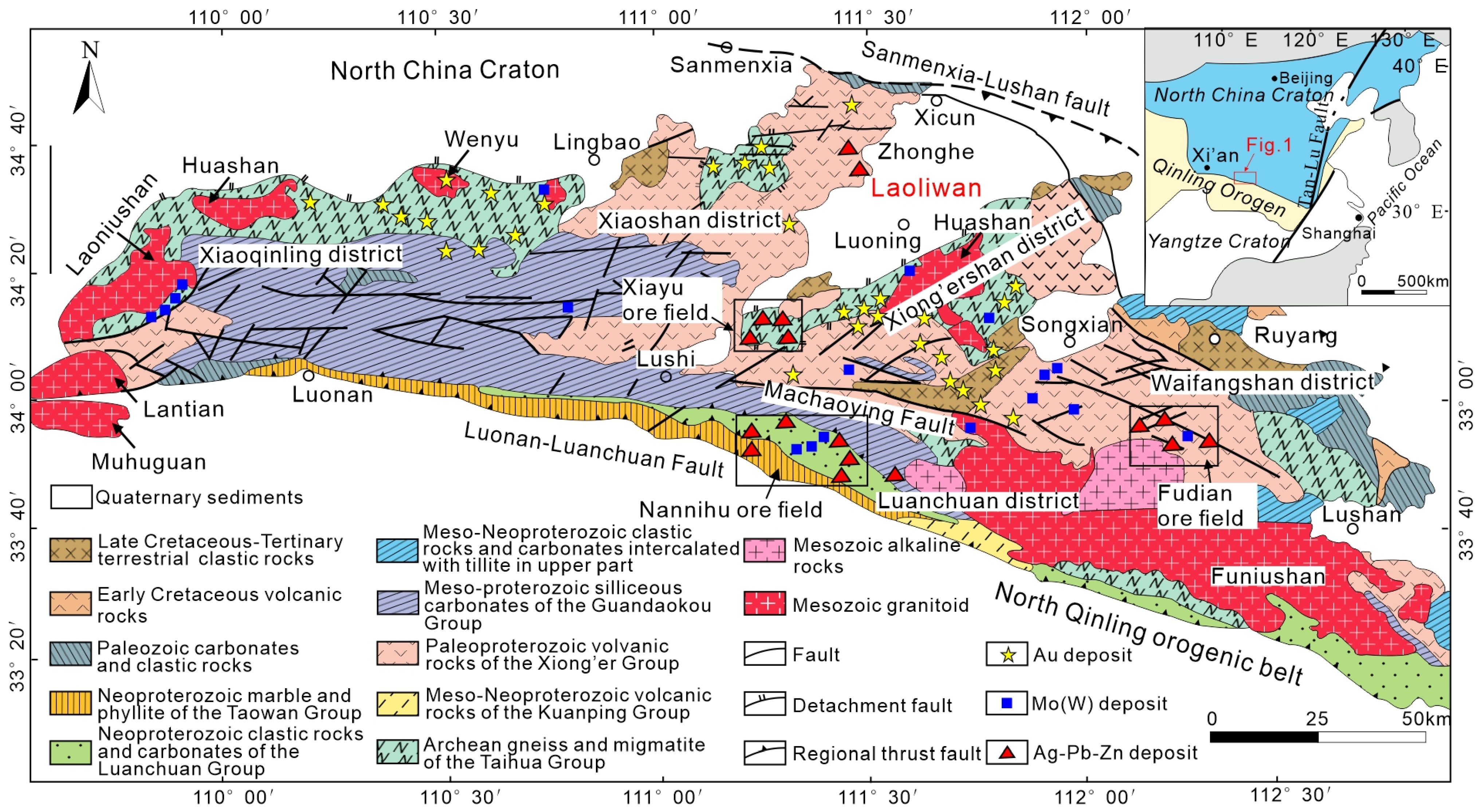
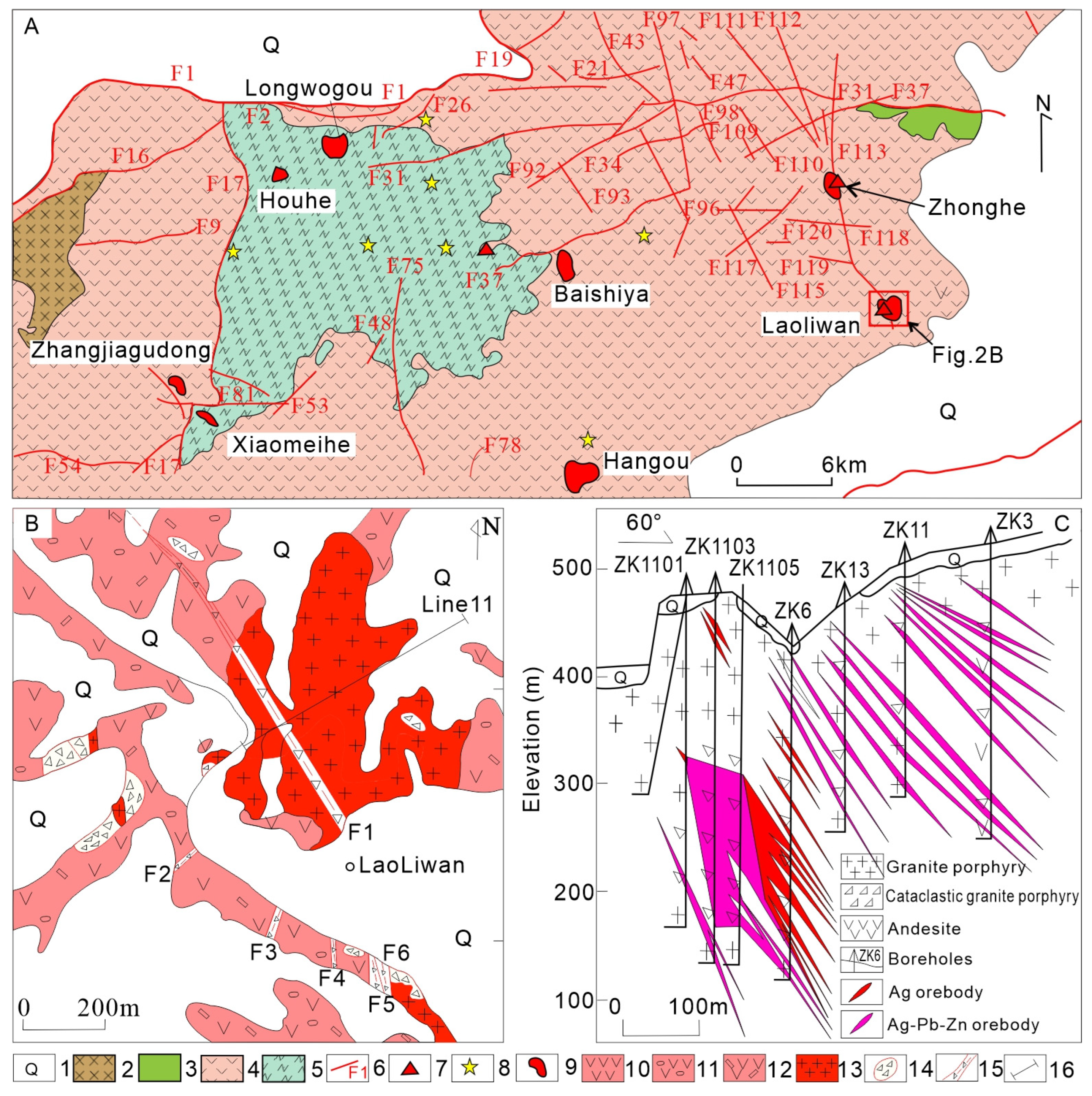
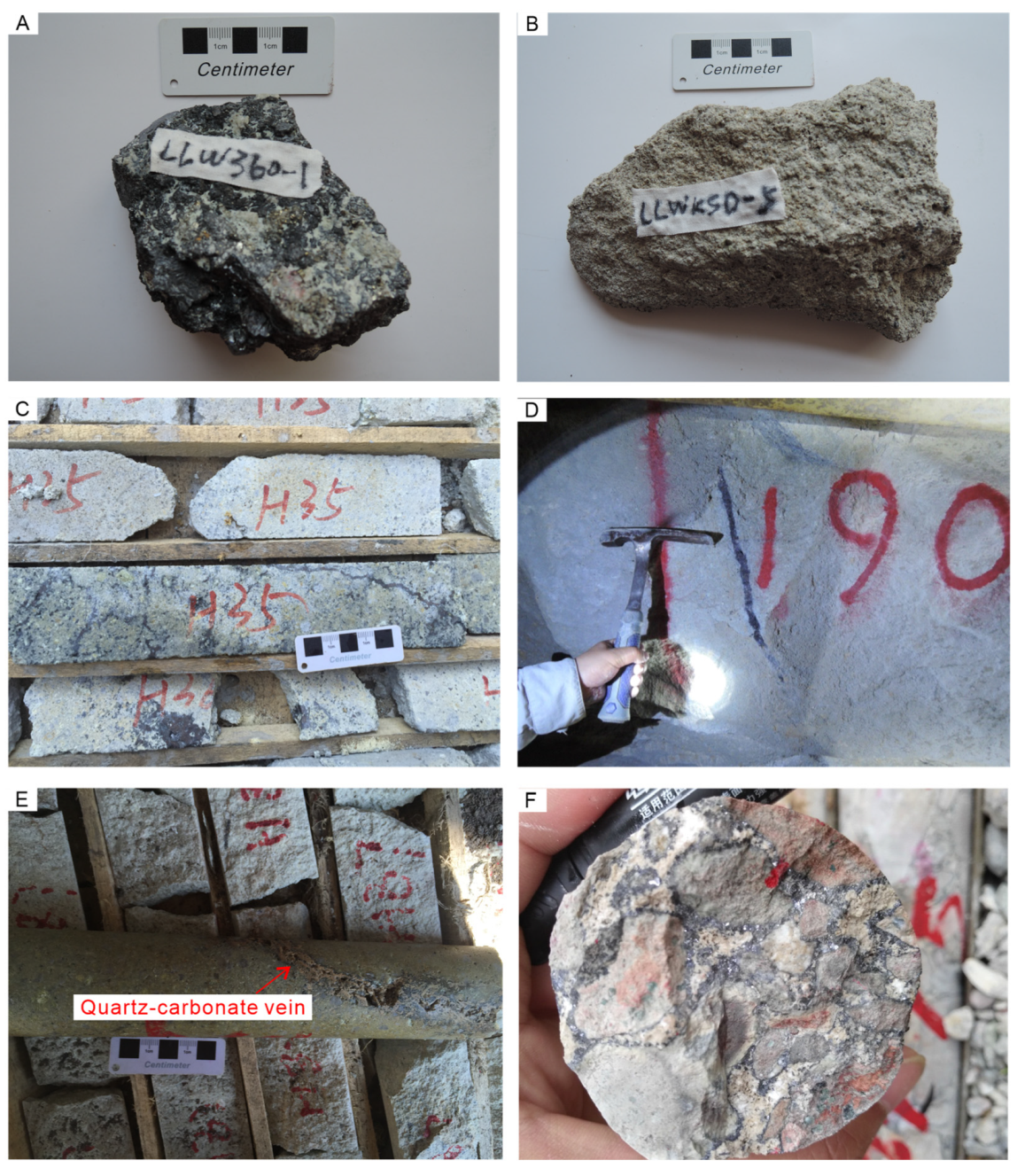
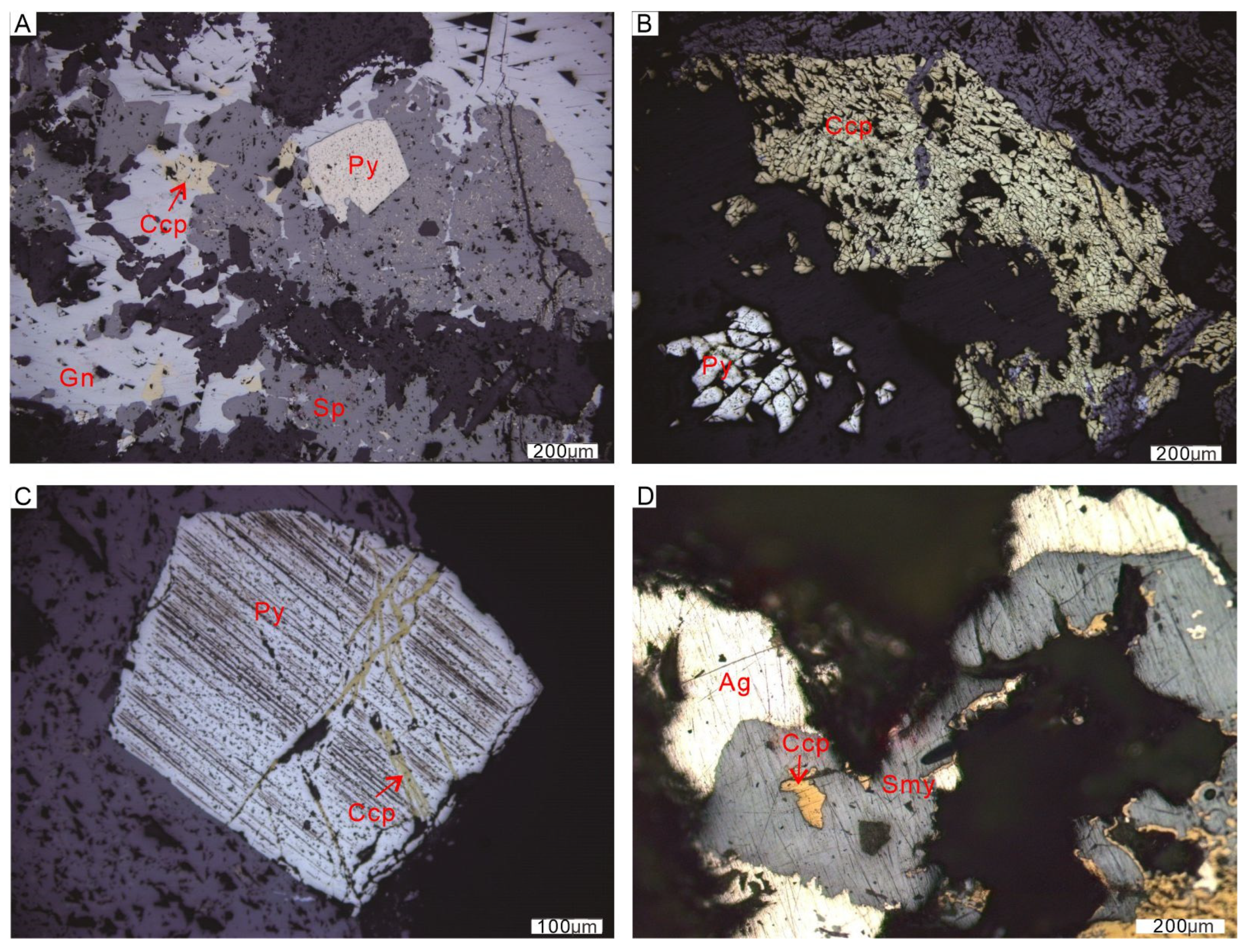

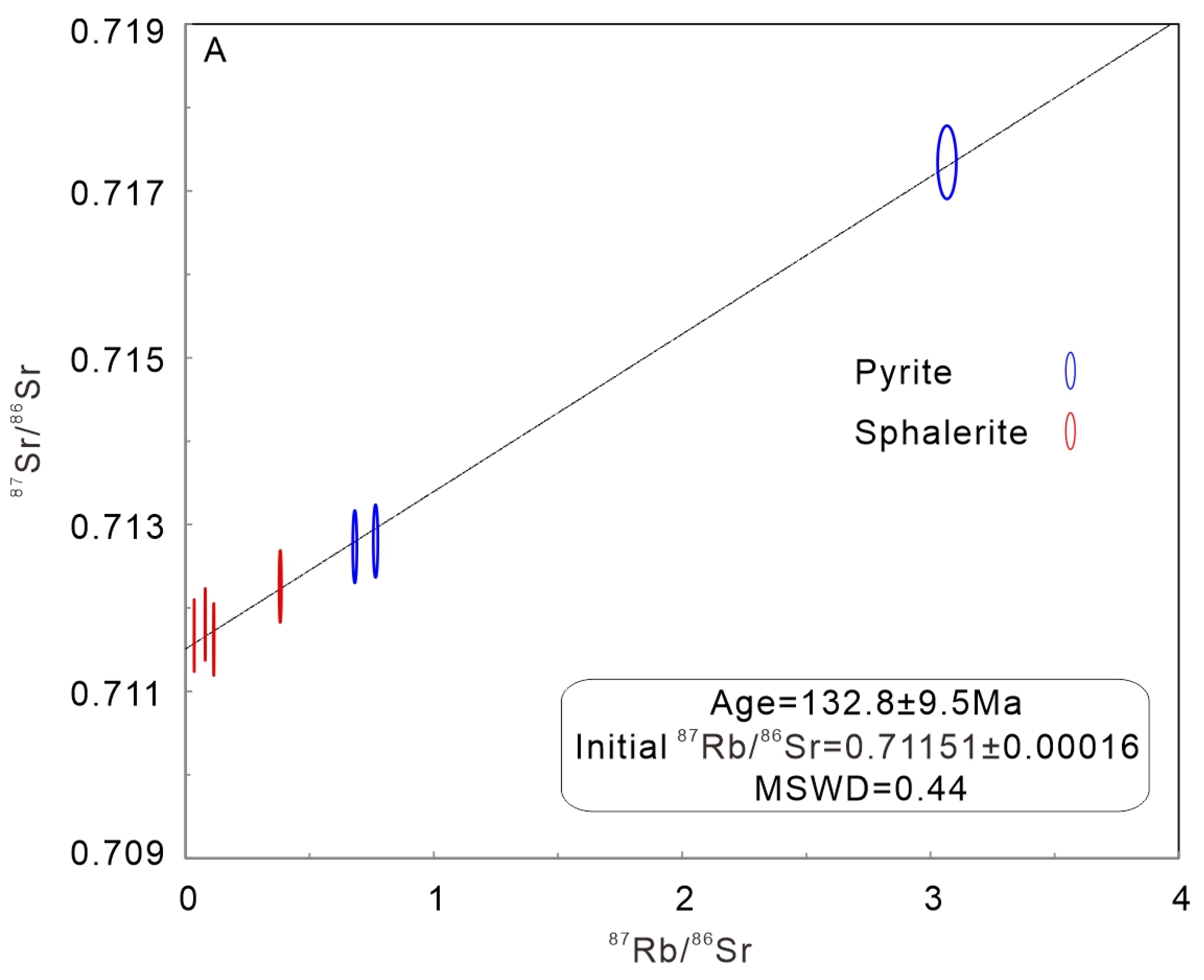
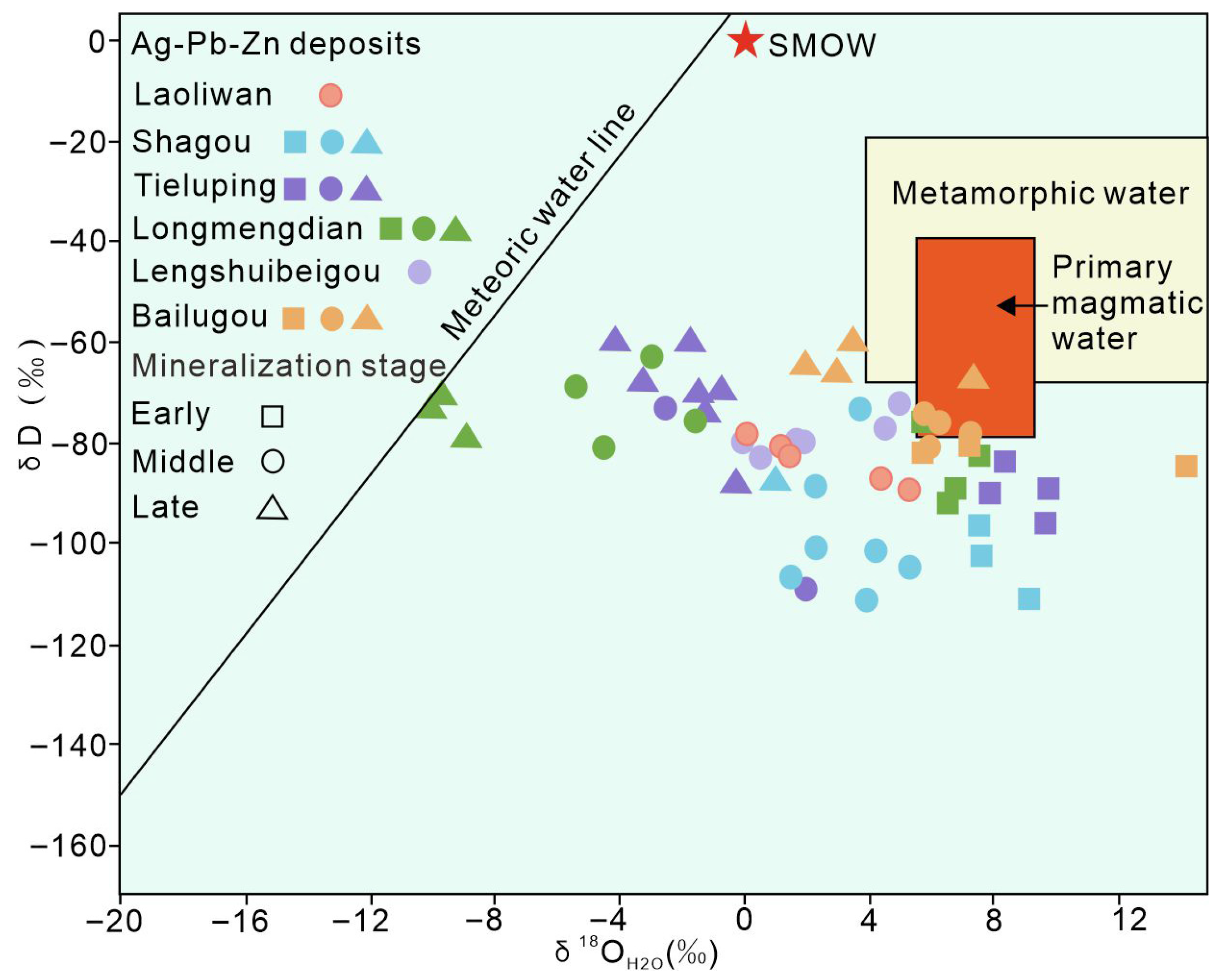
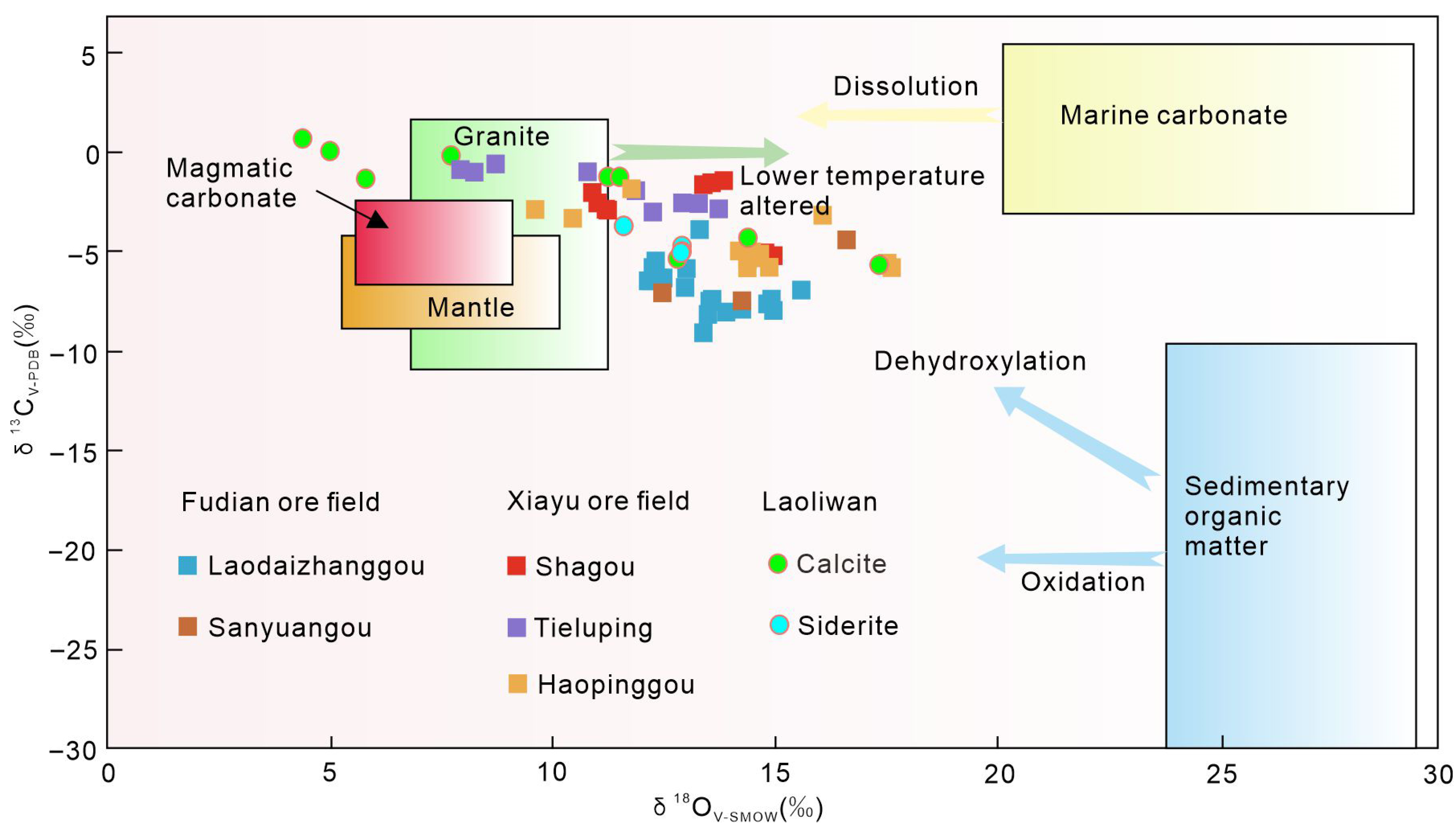
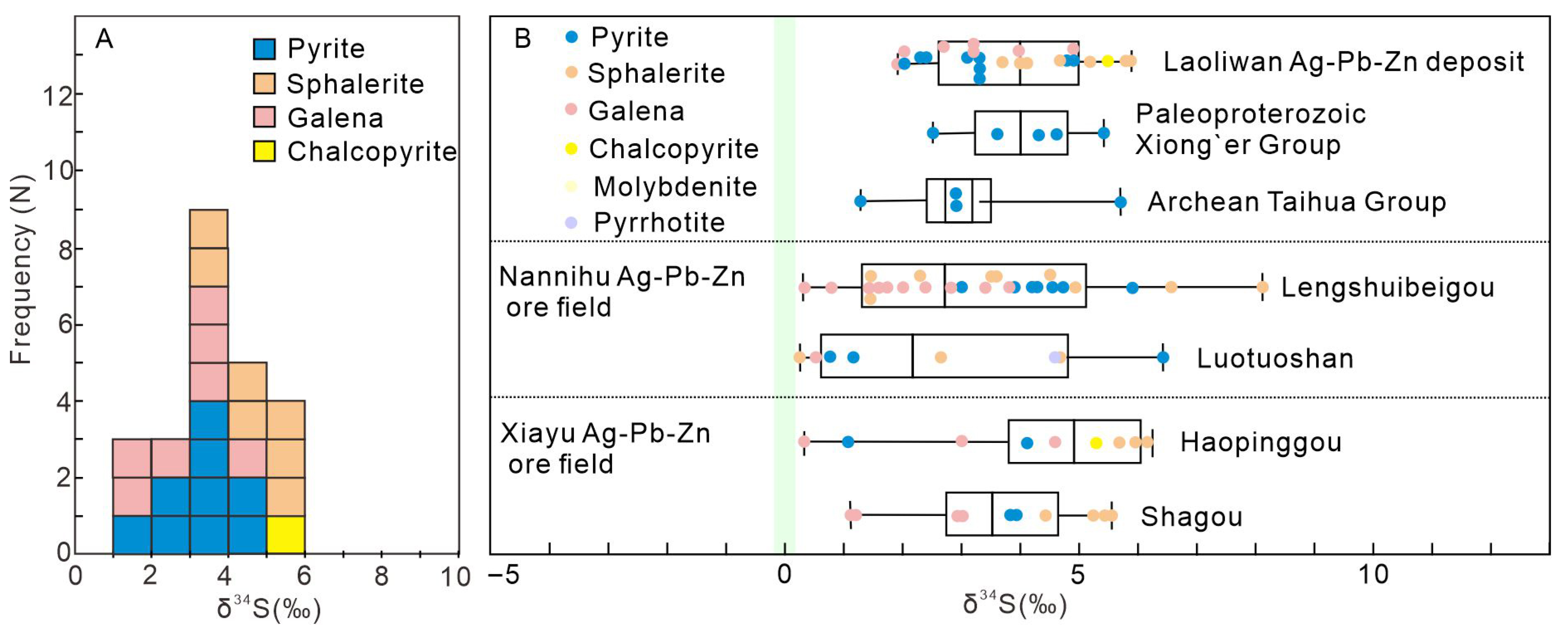
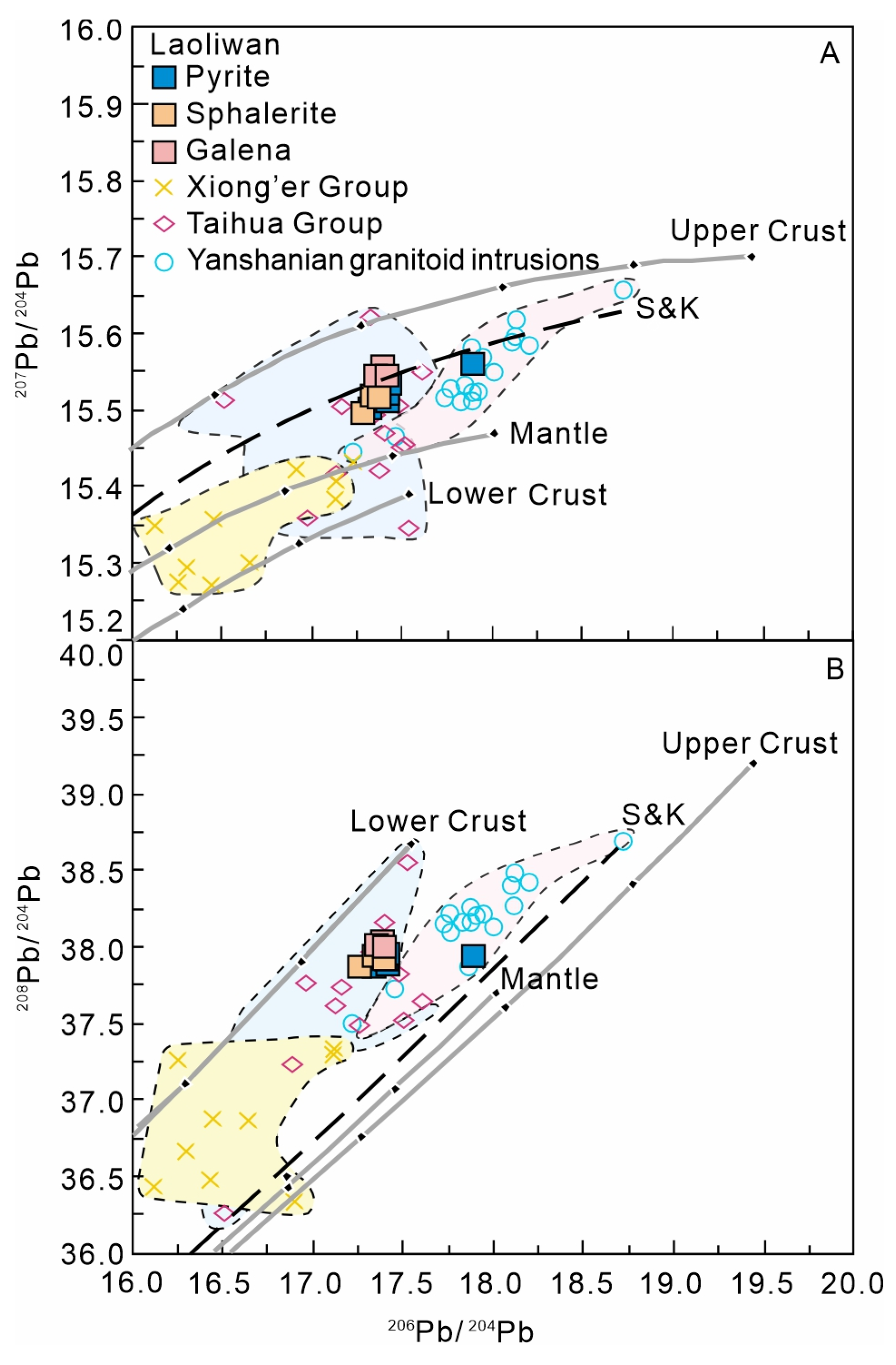
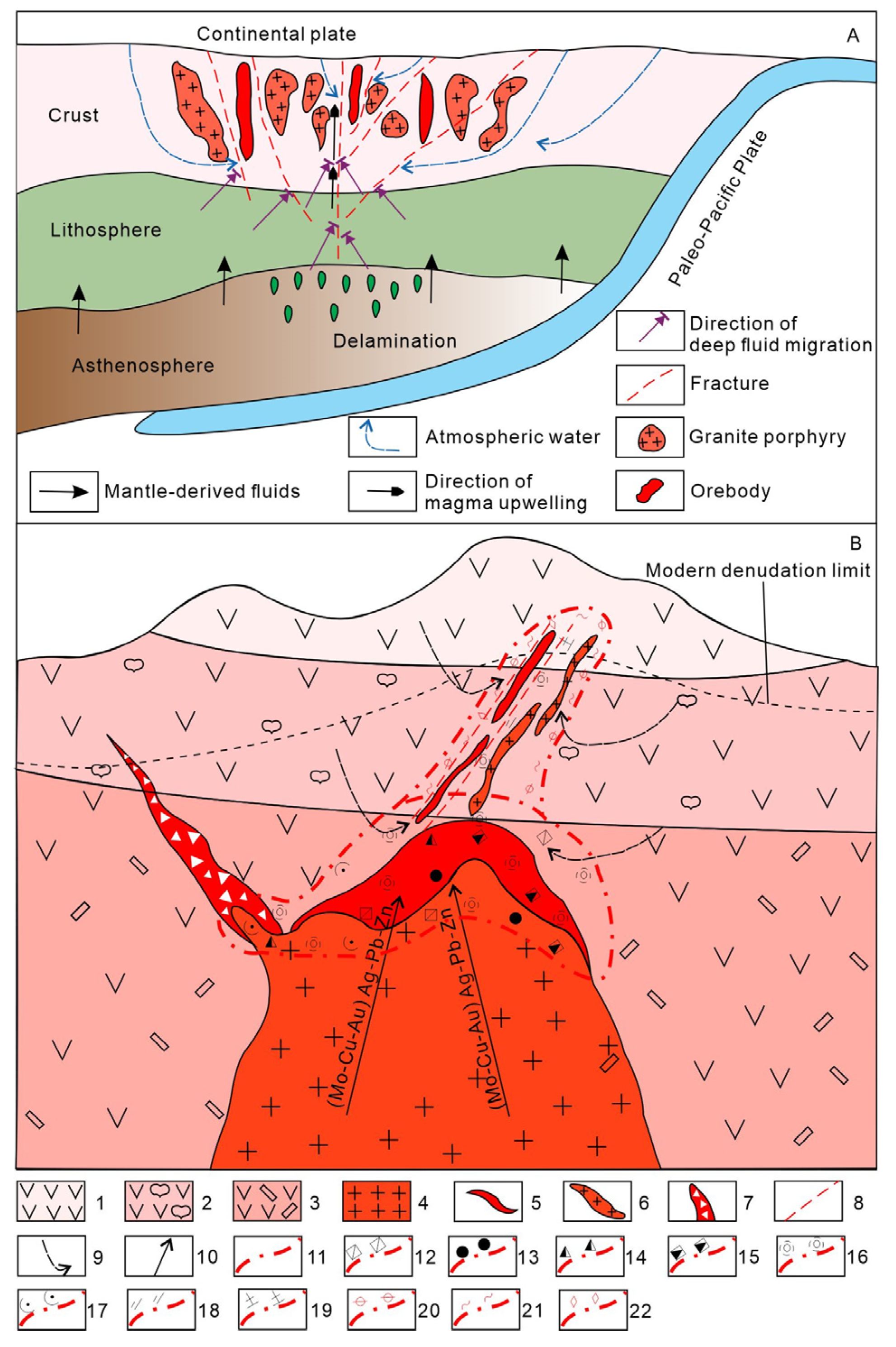
| Sample No. | Minerals | Rb (μg/g) | Sr (μg/g) | 87Rb/86Sr | 87Sr/86Sr | 2σ | 87Sr/86Sr (Isr) |
|---|---|---|---|---|---|---|---|
| KSD-3 | Pyrite | 1.500 | 6.38 | 0.6821 | 0.712735 | 0.000025 | 0.711448 |
| KSD-8 | Pyrite | 1.690 | 6.38 | 0.7657 | 0.712801 | 0.000019 | 0.711356 |
| KSD-13 | Pyrite | 4.170 | 3.94 | 3.0664 | 0.717344 | 0.000014 | 0.711556 |
| LLW-360 | Sphalerite | 0.399 | 3.02 | 0.3821 | 0.712257 | 0.000022 | 0.711536 |
| KSD-1 | Sphalerite | 0.105 | 3.78 | 0.0801 | 0.711802 | 0.000019 | 0.711651 |
| KSD-2 | Sphalerite | 0.115 | 9.59 | 0.0347 | 0.711668 | 0.000014 | 0.711603 |
| LLW-310 | Sphalerite | 0.867 | 22.00 | 0.1140 | 0.711623 | 0.000021 | 0.711408 |
| Ag-Pb-Zn Deposits | Sample No. | Mineralization Stage | Minerals | Th (°C) | δD (‰) | δ18OMineral (‰) | δ18OH2O (‰) | Data Sources |
|---|---|---|---|---|---|---|---|---|
| Laoliwan | LLW310-5-1 | Middle (stage II) | Quartz | 300 | −89.1 | 8.3 | 1.4 | this paper |
| LLW310-5-3 | Middle (stage II) | Quartz | 300 | −86.7 | 7.2 | 0.3 | ||
| LLW310-5-4 | Middle (stage II) | Quartz | 300 | −90.5 | 8.6 | 1.7 | ||
| LLW1507-6-1 | Middle (stage II) | Quartz | 300 | −94.1 | 11.6 | 4.7 | ||
| LLW1507-6-2 | Middle (stage II) | Quartz | 300 | −96.3 | 12.5 | 5.6 | ||
| Shagou | SG071 | Early | Quartz | 236 | −102.1 | 17.2 | 7.6 | [16] |
| SG112 | Early | Quartz | 236 | −110.5 | 18.7 | 9.1 | ||
| SG153 | Early | Quartz | 236 | −96.2 | 17.1 | 7.5 | ||
| 11SG03 | Middle | Quartz | 203 | −100.5 | 13.8 | 2.3 | ||
| 11SG04 | Middle | Quartz | 203 | −106.2 | 13 | 1.5 | ||
| SG012 | Middle | Quartz | 203 | −88.2 | 13.8 | 2.3 | ||
| SG041 | Middle | Quartz | 203 | −100.9 | 15.7 | 4.2 | ||
| SG231 | Middle | Quartz | 203 | −104.4 | 16.8 | 5.3 | ||
| SG35 | Middle | Quartz | 203 | −75.6 | 15 | 3.5 | ||
| SG391 | Middle | Quartz | 203 | −110.7 | 15.4 | 3.9 | ||
| SG311 | Late | Quartz | 182 | −87 | 13.9 | 1.0 | ||
| Tieluping | TS7 | Early | Quartz | 373 | −89 | 15.6 | 9.8 | [15] |
| TS8 | Early | Quartz | 373 | −96 | 15.5 | 9.7 | ||
| TS15 | Early | Quartz | 373 | −84 | 14.2 | 8.4 | ||
| TS20 | Early | Quartz | 373 | −90 | 13.7 | 7.9 | ||
| TS17 | Middle | Quartz | 233 | −109 | 13.0 | 2 | ||
| TS13 | Middle | Quartz | 210 | −73 | 10.1 | −2.5 | ||
| TS10 | Late | Calcite | 158 | −88 | 11.8 | −0.2 | ||
| TS11 | Late | Calcite | 158 | −60 | 10.5 | −1.6 | ||
| TS14 | Late | Calcite | 158 | −74 | 10.9 | −1.2 | ||
| TS16 | Late | Calcite | 158 | −70 | 11.4 | −0.7 | ||
| BT3 | Late | Quartz | 203 | −70 | 11.5 | −1.5 | ||
| BT5 | Late | Quartz | 203 | −68 | 9.8 | −3.2 | ||
| BT10 | Late | Quartz | 203 | −60 | 8.9 | −4.1 | ||
| Longmendian | ZK1002 | Early | Quartz | −83 | 15.9 | 7.6 | [50] | |
| ZK1002 | Early | Quartz | −92 | 14.8 | 6.5 | |||
| ZK301 | Early | Quartz | −76 | 14.1 | 5.8 | |||
| ZK702 | Early | Quartz | −89 | 15.1 | 6.8 | |||
| ZK901 | Middle | Quartz | −63 | 9.7 | −3.0 | |||
| ZK1014 | Middle | Quartz | −81 | 8.3 | −4.4 | |||
| ZK1014 | Middle | Quartz | −69 | 7.4 | −5.3 | |||
| ZK2701 | Middle | Quartz | −76 | 11.2 | −1.5 | |||
| ZK1002 | Late | Quartz | −79 | 7.9 | −8.9 | |||
| ZK1002 | Late | Quartz | −71 | 7.1 | −9.7 | |||
| ZK301 | Late | Calcite | −73 | 6.8 | −10.0 | |||
| Lengshuibeigou | S031-2 | Middle | Quartz | 229 | −80 | 12 | −0.03 | [14] |
| S027-5 | Middle | Quartz | 209 | −83 | 13.9 | 0.53 | ||
| S027-21 | Middle | Quartz | 255 | −80 | 12.5 | 1.93 | ||
| LSBG-3 | Middle | Quartz | 258 | −80.1 | 12.3 | 1.64 | ||
| LSBG-6 | Middle | Quartz | 257 | −77.4 | 15.02 | 4.52 | ||
| LSBG-14 | Middle | Quartz | 230 | −72 | 16.99 | 4.97 | ||
| Bailugou | BLC-30 | Early | Quartz | 380 | −85 | 18.7 | 14.2 | [33] |
| BGL-5 | Early | Quartz | 300 | −82 | 12.7 | 5.8 | ||
| BLC-11 | Early | Quartz | 340 | −81 | 12.6 | 7.0 | ||
| BLC-33 | Middle | Quartz | 250 | −81 | 15.0 | 6.0 | ||
| BLC-32 | Middle | Quartz | 280 | −78 | 14.9 | 7.3 | ||
| BLC-13 | Middle | Quartz | 330 | −76 | 12.2 | 6.3 | ||
| BLY-12 | Middle | Quartz | 280 | −74 | 13.4 | 5.8 | ||
| BLC-30 | Late | Dolomite | 250 | −67 | 15.4 | 7.4 | ||
| BGL-12 | Late | Dolomite | 280 | −66 | 9.8 | 3.0 | ||
| BJD-2 | Late | Dolomite | 250 | −65 | 9.9 | 2.0 | ||
| BLY-21 | Late | Dolomite | 250 | −60 | 11.4 | 3.5 |
| Ag-Pb-Zn Deposits | Sample No. | Minerals | δ18CV-PDB(‰) | δ18OV-SMOW (‰) | δ18OV-PDB (‰) | Data Resources |
|---|---|---|---|---|---|---|
| Laoliwan | LLWKSD-2-1 | Calcite | 0.7 | 4.4 | −25.7 | this paper |
| LLWKSD-2-2 | Calcite | 0.1 | 5.0 | −25.2 | ||
| LLWKSD-2-3 | Calcite | −1.3 | 5.8 | −24.4 | ||
| LLW-73-4 | Siderite | −3.7 | 11.6 | −18.8 | [22] | |
| LLW-119 | Siderite | −4.7 | 12.9 | −17.5 | ||
| LLW-123 | Siderite | −4.7 | 12.9 | −17.5 | ||
| LLW-126 | Siderite | −4.9 | 12.9 | −17.5 | ||
| LLW-21-2 | Calcite | −5.6 | 17.4 | −13.1 | ||
| LLW-22-1 | Calcite | −4.3 | 14.4 | −16 | ||
| LLW-27 | Calcite | −5.4 | 12.8 | −17.6 | ||
| LLW-K-1 | Calcite | −1.2 | 11.2 | −19.1 | ||
| LLW-K-2 | Calcite | −0.2 | 7.7 | −22.5 | ||
| LLW-KD-2 | Calcite | −1.2 | 11.5 | −18.9 | ||
| Shagou | SG52-1 | Siderite | −2.9 | 11.2 | [8] | |
| SG80 | Siderite | −2.0 | 10.9 | |||
| SC12 | Siderite | −2.6 | 11.0 | |||
| SG57 | Siderite | −2.8 | 11.2 | |||
| SG52-2 | Ankerite | −1.5 | 13.6 | |||
| SG40 | Ankerite | −1.4 | 13.8 | |||
| SG41 | Ankerite | −1.6 | 13.4 | |||
| SG53 | Calcite | −5.1 | 14.7 | |||
| SG55 | Calcite | −5.2 | 15.0 | |||
| Tieluping | TLP-4 | Siderite | −1.92 | 11.86 | −18.48 | [52] |
| TLP-28-1 | Siderite | −3.03 | 12.26 | −18.09 | ||
| TLP-11-2 | Siderite | −2.56 | 12.93 | −17.44 | ||
| TLP-38 | Siderite | −2.57 | 13.29 | −17.09 | ||
| TLP-76 | Siderite | −2.85 | 13.73 | −16.67 | ||
| TLP-2 | Dolomite | −1.00 | 10.78 | −19.52 | ||
| TLP-25 | Dolomite | −0.61 | 8.73 | −21.52 | ||
| TLP-71 | Calcite | −0.98 | 8.25 | −21.98 | ||
| TLP-38-1 | Calcite | −0.89 | 7.93 | −22.29 | ||
| Haopinggou | HP56 | Siderite | −5.73 | 14.88 | −15.55 | [53] |
| HP57 | Siderite | −5.82 | 14.32 | −16.09 | ||
| HP58 | Siderite | −5.04 | 14.56 | −15.86 | ||
| HP65 | Siderite | −5.09 | 14.62 | −15.80 | ||
| HP68-1 | Siderite | −5.38 | 14.69 | −15.73 | ||
| HP76 | Siderite | −5.45 | 14.39 | −16.02 | ||
| HP52 | Ankerite | −3.09 | 16.06 | −14.40 | ||
| HP68-2 | Ankerite | −5.66 | 17.61 | −12.90 | ||
| HP69 | Ankerite | −5.60 | 17.59 | −12.92 | ||
| HP71 | Ankerite | −4.97 | 14.20 | −16.21 | ||
| HP07 | Calcite | −2.84 | 9.62 | −20.65 | ||
| HP21 | Calcite | −3.31 | 10.47 | −19.83 | ||
| HP61 | Calcite | −1.84 | 11.75 | −18.59 | ||
| Laodaizhanggou | LD58-1 | Siderite | −6.8 | 13 | −17.4 | [9] |
| LD77-1 | Siderite | −5.5 | 12.3 | −18.1 | ||
| LD78-1 | Siderite | −6.3 | 12.5 | −17.9 | ||
| LD80-1 | Siderite | −6.5 | 12.2 | −18.1 | ||
| LD82 | Siderite | −6.5 | 12.1 | −18.3 | ||
| LD83-1 | Siderite | −6.3 | 12.4 | −18.0 | ||
| LD10 | Ankerite | −8.1 | 13.5 | −16.9 | ||
| LD11-1 | Ankerite | −7.8 | 14.2 | −16.2 | ||
| LD14 | Ankerite | −8.0 | 13.9 | −16.5 | ||
| LD20 | Ankerite | −7.5 | 13.5 | −16.9 | ||
| LD77-2 | Ankerite | −3.9 | 13.3 | −17.1 | ||
| LD78-2 | Ankerite | −5.8 | 13.0 | −17.4 | ||
| LD80-2 | Ankerite | −7.4 | 13.6 | −16.8 | ||
| LD83-2 | Ankerite | −9.1 | 13.4 | −17.0 | ||
| LD09 | Calcite | −6.9 | 15.6 | −14.9 | ||
| LD11-2 | Calcite | −5.8 | 12.2 | −18.2 | ||
| LD58-2 | Calcite | −7.4 | 14.9 | −15.5 | ||
| LD61 | Calcite | −7.6 | 14.8 | −15.6 | ||
| LD70 | Calcite | −7.9 | 14.9 | −15.6 | ||
| Sanyuangou | SY07 | Calcite | −7.62 | 14.2 | −16.21 | [53] |
| SY08-1 | Ankerite | −4.37 | 16.61 | −13.87 | ||
| SY08-2 | Calcite | −7.04 | 12.46 | −17.9 |
| Sample No. | Minerals | δ34S (‰) | Data Resources |
|---|---|---|---|
| LLWKSD-7 | Pyrite | 2.0 | This study |
| LLWKSD-12 | Pyrite | 4.9 | |
| LLW310-6 | Pyrite | 4.8 | |
| LLW707-2 | Pyrite | 3.1 | |
| LLW707-1 | Sphalerite | 4.7 | |
| LLW360-3-2 | Chalcopyrite | 5.5 | |
| LLW360-1-1 | Pyrite | 2.3 | |
| LLW360-3-1 | Galena | 3.2 | |
| LLW360-3-4 | Sphalerite | 5.2 | |
| LLW310-5-1 | Galena | 4.0 | |
| LLW310-5-3 | Sphalerite | 5.8 | |
| LLW310-7 | Galena | 3.2 | |
| LLW28 | Galena | 4.9 | [47] |
| LLW114 | Pyrite | 3.3 | |
| LLW115 | Pyrite | 2.4 | |
| LLW124 | Pyrite | 3.3 | |
| LLW127 | Pyrite | 3.3 | |
| LLW32 | Galena | 1.9 | |
| LLW136 | Sphalerite | 4.0 | |
| LLW138 | Galena | 2.0 | |
| LLW35 | Sphalerite | 5.9 | |
| LLW40 | Sphalerite | 4.1 | |
| LLW139 | Sphalerite | 3.7 | |
| LLW151 | Galena | 2.7 |
| Sample No. | Minerals | 208Pb/204Pb | 2σ | 207Pb/204Pb | 2σ | 206Pb/204Pb | 2σ |
|---|---|---|---|---|---|---|---|
| LLWKSD-7 | Pyrite | 37.953 | 0.006 | 15.560 | 0.002 | 17.892 | 0.003 |
| LLWKSD-12 | Pyrite | 37.904 | 0.006 | 15.516 | 0.002 | 17.405 | 0.003 |
| LLW310-6 | Pyrite | 37.925 | 0.006 | 15.523 | 0.003 | 17.402 | 0.003 |
| LLW707-2 | Pyrite | 37.943 | 0.004 | 15.534 | 0.002 | 17.411 | 0.002 |
| LLW707-1 | Sphalerite | 37.873 | 0.004 | 15.498 | 0.002 | 17.301 | 0.002 |
| LLW360-1-1 | Pyrite | 37.884 | 0.009 | 15.507 | 0.003 | 17.343 | 0.003 |
| LLW360-3-1 | Galena | 37.992 | 0.005 | 15.541 | 0.002 | 17.406 | 0.003 |
| LLW360-3-4 | Sphalerite | 37.916 | 0.006 | 15.520 | 0.002 | 17.392 | 0.003 |
| LLW310-5-1 | Galena | 38.029 | 0.004 | 15.548 | 0.002 | 17.393 | 0.002 |
| LLW310-5-3 | Sphalerite | 37.930 | 0.005 | 15.518 | 0.002 | 17.364 | 0.003 |
| LLW310-7 | Galena | 37.998 | 0.005 | 15.540 | 0.002 | 17.386 | 0.002 |
Disclaimer/Publisher’s Note: The statements, opinions and data contained in all publications are solely those of the individual author(s) and contributor(s) and not of MDPI and/or the editor(s). MDPI and/or the editor(s) disclaim responsibility for any injury to people or property resulting from any ideas, methods, instructions or products referred to in the content. |
© 2025 by the authors. Licensee MDPI, Basel, Switzerland. This article is an open access article distributed under the terms and conditions of the Creative Commons Attribution (CC BY) license (https://creativecommons.org/licenses/by/4.0/).
Share and Cite
Xue, J.; Pang, Z.; Chen, H.; Ding, P.; Jia, R.; Tao, W.; Shen, R.; Zhang, B.; Mou, N.; Yang, Y. Genesis of the Laoliwan Ag-Pb-Zn Deposit, Southern Margin of the North China Craton, China: Constrained by C-H-O-S-Pb Isotopes and Sulfide Rb-Sr Geochronology. Minerals 2025, 15, 1122. https://doi.org/10.3390/min15111122
Xue J, Pang Z, Chen H, Ding P, Jia R, Tao W, Shen R, Zhang B, Mou N, Yang Y. Genesis of the Laoliwan Ag-Pb-Zn Deposit, Southern Margin of the North China Craton, China: Constrained by C-H-O-S-Pb Isotopes and Sulfide Rb-Sr Geochronology. Minerals. 2025; 15(11):1122. https://doi.org/10.3390/min15111122
Chicago/Turabian StyleXue, Jianling, Zhenshan Pang, Hui Chen, Peichao Ding, Ruya Jia, Wen Tao, Ruifeng Shen, Banglu Zhang, Nini Mou, and Yan Yang. 2025. "Genesis of the Laoliwan Ag-Pb-Zn Deposit, Southern Margin of the North China Craton, China: Constrained by C-H-O-S-Pb Isotopes and Sulfide Rb-Sr Geochronology" Minerals 15, no. 11: 1122. https://doi.org/10.3390/min15111122
APA StyleXue, J., Pang, Z., Chen, H., Ding, P., Jia, R., Tao, W., Shen, R., Zhang, B., Mou, N., & Yang, Y. (2025). Genesis of the Laoliwan Ag-Pb-Zn Deposit, Southern Margin of the North China Craton, China: Constrained by C-H-O-S-Pb Isotopes and Sulfide Rb-Sr Geochronology. Minerals, 15(11), 1122. https://doi.org/10.3390/min15111122





